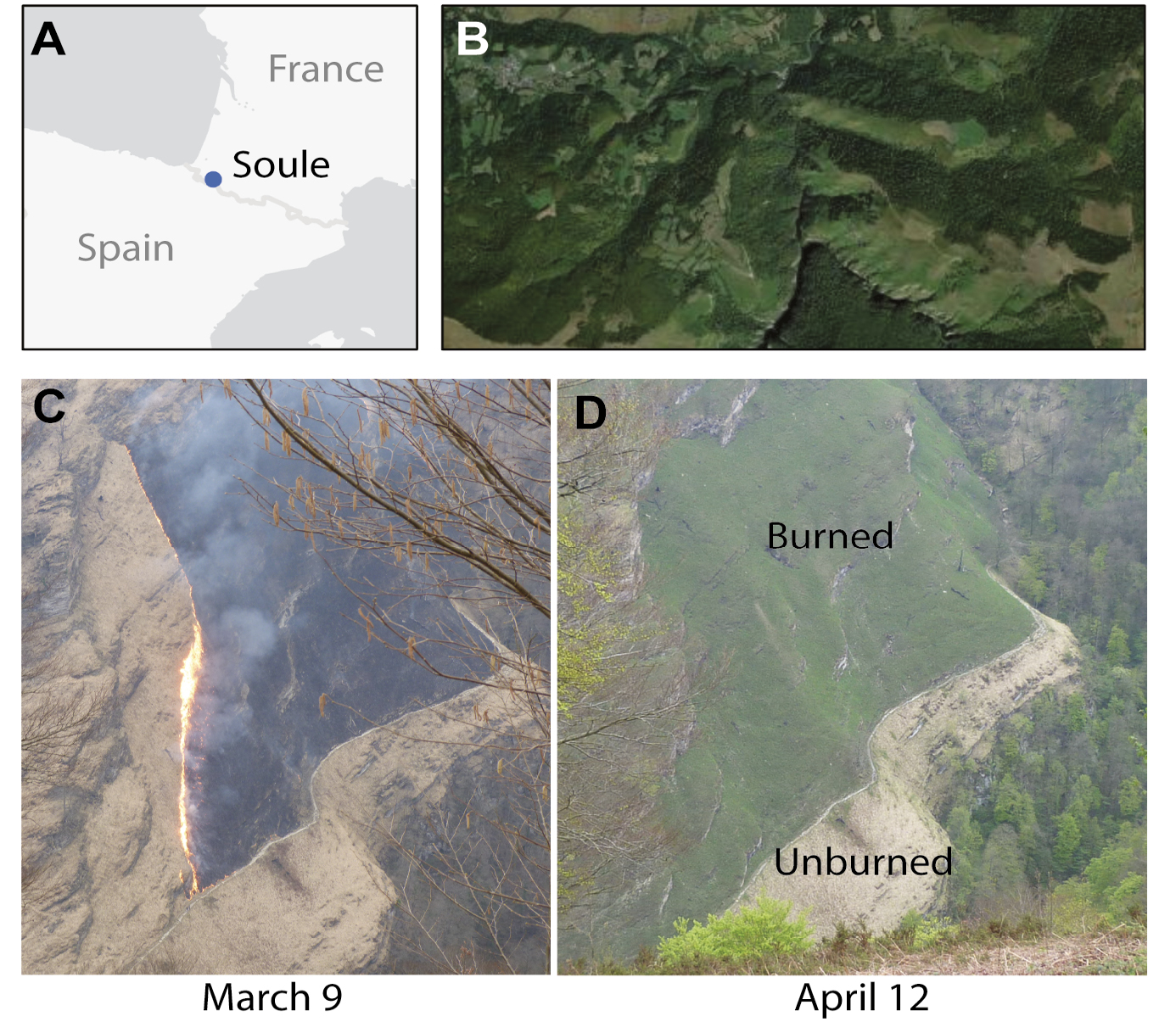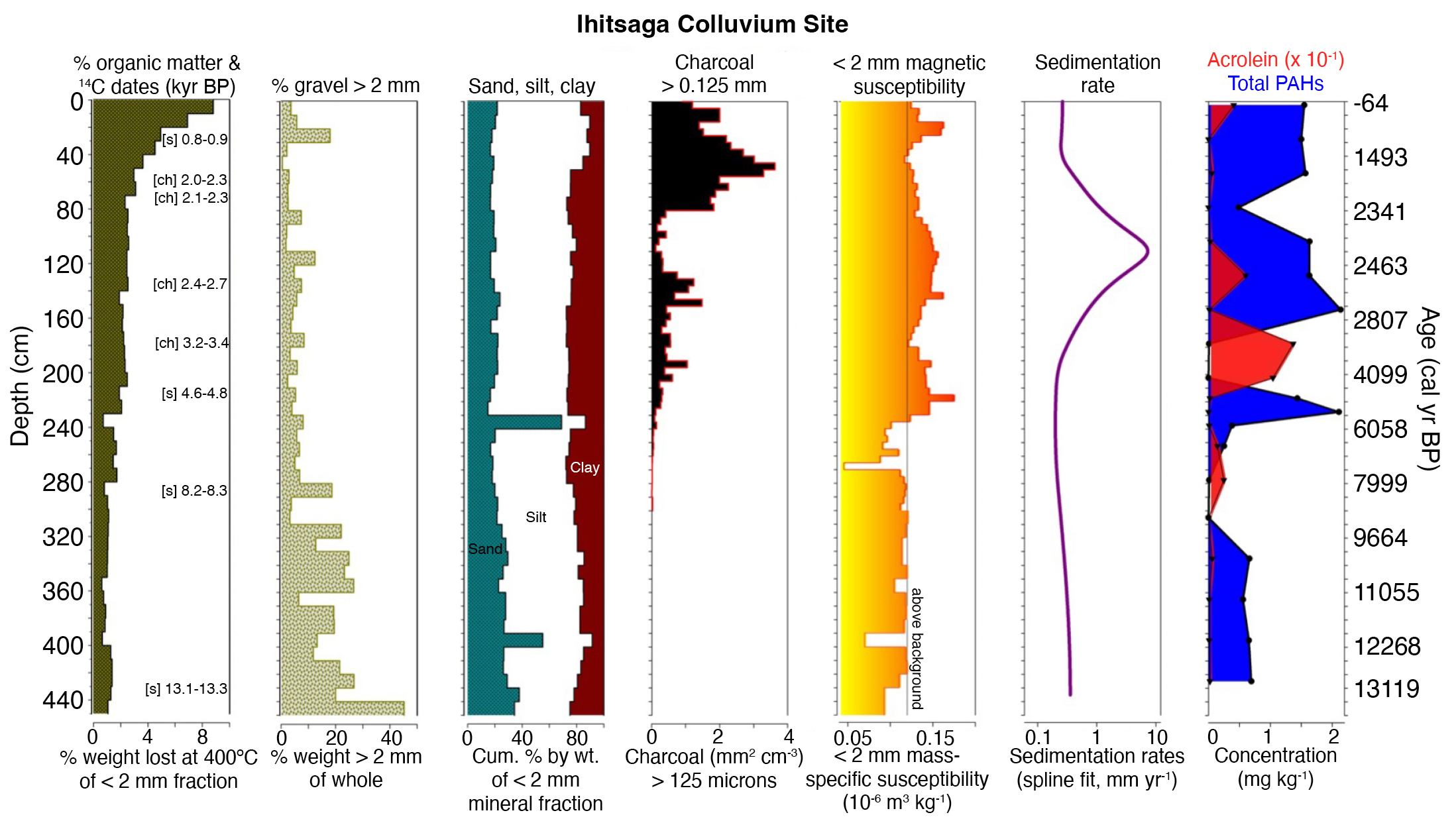- Home
- Publications
- PAGES Magazine
- Landscape Conservation and The Ancient Technique of Pastoral Fire In The Western Pyrenees
Landscape conservation and the ancient technique of pastoral fire in the western Pyrenees
Coughlan MR, Gragson TL and Leigh DS
Past Global Changes Magazine
30(1)
38-39
2022
Michael R. Coughlan1, T.L. Gragson2 and D.S. Leigh3
Multi-proxy evidence suggests that pastoral fire use has spanned thousands of years in the western Pyrenees. Our place-based integration of traditional knowledge with paleoecological, historical, and archaeological sciences points to Basque pastoral burning techniques as effective tools for conserving the cultural landscapes of the Pyrenees.
Basque stock raisers (éleveurs in French) in the western Pyrenees use fire as a tool to manage hedgerows and to clean and renew meadows and pastures (Coughlan 2013, 2014). Scholars generally recognize that the practice of "pastoral fire" (feu pastoral in French) is ancient and that it historically played a significant role in land management in the Pyrenees (Métailié 2006). Yet, the practice of pastoral fire is heavily regulated by the French state and continues to be regarded with suspicion by many forest- and fire-management officials who consider it a haphazard and environmentally irresponsible practice (Coughlan 2013). Given these competing narratives, the appropriateness (perhaps necessity) of pastoral fire as a landscape conservation tool is seldom considered.
Our place-based investigation of pastoral fire integrates diverse types of knowledge (i.e. traditional knowledge in addition to historical, archaeological, and paleoecological archives) to understand when the practice first began and the long-term effects of burning on soils and vegetation patterns within an ethnically Basque province of Soule (Xiberoa in Souletin Basque) in the French western Pyrenees. Our results point to traditional pastoral fire use as a practical and effective tool for conserving ancient cultural landscapes comprised of forest-meadow mosaics and seasonal upland pastures.
Ethnography of pastoral fire use
Basque peoples have likely inhabited the western Pyrenees for at least the last several thousand years, culturally adapting to, and shaping, the environment there (Gragson et al. 2020). Generation after generation of Basque shepherds have successfully passed on the place-based traditional knowledge of how to burn landscapes in ways that help to ensure the long-term sustainability of ecosystem goods and services.
Following this long tradition, today's stock raisers set culturally prescribed fires in the mid-elevation mountains (300–800 m asl) with relative ease during mid to late winter months, and higher up the mountainside in the early spring. Bracken (Pterdidium spp.) and false broom (Brachypodium sylvaticum) growing in the mid-elevation forest-meadow matrix are the first to be burned. These fires remove the unpalatable cured grasses from the previous growing season, but also burn seedlings and new sprouts from tree roots, which prevents the encroachment of trees into pastures and meadows. New grass shoots soon appear, resulting in nutrient-rich forage for the transhumant livestock herds as they are shepherded toward higher elevation summer pastures (Fig. 1).
This burning usually takes place in February and March, when the weather patterns have shifted from a cool and wet Atlantic pattern, to a sunny and warm Mediterranean pattern, driven by dry Foehn winds. Fuels are cured and ready to burn after about three days of sunny, warm weather, and fires spread rapidly until petering out at the edge of the forest where they are extinguished by the more humid, less flammable fuels under the beech (Fagus sylvatica) forest canopy. On more sheltered slopes, clumps of heather (Calluna vulgaris) and gorse (Ulex europaeus) are generally ignited individually. These burn rapidly, creating copious amounts of smoke, but due to their patchy growth, they require multiple ignition points. Common juniper (Juniperus communis) is treated similarly at higher elevations. Burning above 800 m asl generally begins in late March and runs into May, although smaller fires, sometimes targeting individual shrubs, are set throughout the summer months.
Paleoecological evidence for woodland-to-pasture conversion
Multiproxy paleoecological evidence (i.e. charcoal, soil magnetic susceptibility, acrolein and polycyclic aromatic hydrocarbons, chemical compounds that are indicative of fire and strongly bound to soil particles) derived from stratigraphically sampled slopewash deposits (zero-order, small hollow colluvium) show a distinct increase in fire activity around 5000–6000 yr before present (BP), based on radiocarbon chronologies (Fig. 2; Leigh et al. 2015, 2016; Gragson et al. 2020; Coughlan et al. in press). These paleoenvironmental archives occur in continuous sedimentation records from about 18,000 yr BP to the present and suggest that late Neolithic people pioneered intentional use of fire in a region where natural fires were rare (Jalut et al. 2000). Non-synchronous peaks in proxies from different sediment sample sites indicate a highly localized, as opposed to regional, pattern of fire use, especially during the Neolithic through to the Bronze Age. Following the Bronze Age, charcoal concentrations steadily increased or remained high, indicating widespread use of fire. Pronounced sedimentation rates spike in conjunction with some of the Iron Age through Middle Age peaks in charcoal, suggesting excessive levels of soil erosion, but sedimentation rates generally settled down by Modern times. Thick, organic-rich horizons of modern soils indicate that the fire-based land management practices contribute to sustainability of soils.
Historical and archaeological evidence for the persistence of pastoral economies
An archaeological survey of approximately 4710 hectares of upland pastures (elevations greater than 800 m asl) located nearly 200 archaeological features (stone and earthen foundations, enclosures, and mounds) thought to be associated with seasonal herding activities (Le Couédic et al. 2014). Based on 24 radiocarbon dates of charcoal from seven widespread archaeological features, land-use intensity in the upland pastures peaked only in the last 1000 years (Gragson et al. 2020; Coughlan et al. in press). This archaeological evidence for land-use intensification coincides with historical and archaeological evidence for year-round settlement of nearby farming households located between 300 and 600 m asl. Historical records show that farming communities accessing the upland pastures in Soule have existed since at least the 11th century CE (Gragson et al. 2020). Diverse historical documents suggest that many of the household farm estates at the foot of these pastures were established at least 500–600 years ago, but some of these were abandoned in the latter half of the 20th century (Gragson et al. 2015; Coughlan and Gragson 2016).
An archaeological survey of approximately 18 household farm estates and surrounding communal areas suggested that settlement density, in terms of domestic and agricultural structures, reached its maximum around the late 18th to early 19th century (Coughlan and Gragson 2016). This timing coincides with parcel-level land-use mapping recorded in the 1830 Napoleonic cadaster, thus providing a record of the landscape at its most intensive period of use. Records and observations from recent decades show that pastoral fires have been confined to areas that were registered as pasture land-use in the 1830 cadaster (Coughlan 2013). Comparison of historical aerial photos (1940s-2003) and digitally mapped cadastral records from the 1830s suggest that forest–pasture edges have remained relatively stable over the last 200 years. Further, tree-ring archives show that trees along the forest-pasture boundaries predate the 1830 mapping efforts (Gragson et al. 2020). In other words, despite persistent and frequent use of fire, pastures have not expanded beyond their 1830 boundaries.
Implications for landscape conservation
The integration and synthesis of these diverse forms of evidence suggest that pastoral fire is a stable management practice that has helped to maintain a cultural landscape mosaic of pastures and forests (Coughlan 2014). Contemporary Basque stock raisers face a number of social and economic challenges, and many are abandoning agriculture altogether. A small number of remaining stock raisers continue to employ traditional burning techniques, but find it difficult to meet their management goals while complying with protocols spelled out in official regulations. Land managers and policymakers in Europe and elsewhere can learn from traditional pastoral fire and should make efforts to facilitate the continuation of this vital ancient management practice.
affiliations
1Institute for a Sustainable Environment, University of Oregon, Eugene, OR, USA
2Department of Anthropology, University of Georgia, Athens, GA, USA
3Department of Geography, University of Georgia, Athens, GA, USA
contact
Michael R. Coughlan: mcoughla uoregon.edu
uoregon.edu
references
Coughlan MR (2013) J Ethnobiol 33: 86-104
Coughlan MR (2014) For Ecol Manage 312: 55-66
Coughlan MR, Gragson TL (2016) Hum Ecol 44: 65-80
Coughlan MR et al. (In Press) In: Garcia A (Ed) Archaeology Of Mountain Landscapes: Interdisciplinary Research Strategies Of Agro-Pastoralism In Upland Regions. SUNY Press
Gragson TL et al. (2020) Sustainability 12: 3882
Jalut G et al. (2000) Palaeogeogr Palaeoclimatol Palaeoecol 160: 255-290
Le Couédic M et al. (2014) ITEM, EA 3002. Université de Pau et des Pays de l'Adour, 129 pp
Leigh DS et al. (2015) Zeitschrift für Geomorphol 59: 225-245


